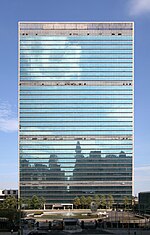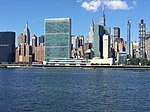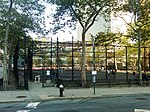United Nations Slavery Memorial
United Nations Slavery Memorial, officially known as The Permanent Memorial at the United Nations in Honour of the Victims of Slavery and the Transatlantic Slave Trade, is an installation at the Headquarters of the United Nations in New York City intended as a permanent reminder of the long-lasting effects of slavery and the slave trade.The Slavery Memorial concept came from various resolutions adopted by the UN General Assembly including A/RES/62/122, A/RES/63/5, and the Durban Declaration.The memorial was designed by Haitian-American architect Rodney Leon, and unveiled on March 25, 2015. It includes three main elements: a large triangular sculpture with a map depicting the triangular slave trade; a prone human figure depicting those who were transported overseas enslaved; and a reflecting pool mean to honour the memory of those who died in slavery. The project was supported by the Permanent Memorial Trust Fund; the estimated cost of the project prior to its construction was 4.5 million dollars.
Excerpt from the Wikipedia article United Nations Slavery Memorial (License: CC BY-SA 3.0, Authors).United Nations Slavery Memorial
East 42nd Street, New York Manhattan
Geographical coordinates (GPS) Address Nearby Places Show on map
Geographical coordinates (GPS)
| Latitude | Longitude |
|---|---|
| N 40.7483 ° | E -73.9679 ° |
Address
United Nations South Annex Building
East 42nd Street 423
10017 New York, Manhattan
New York, United States
Open on Google Maps










